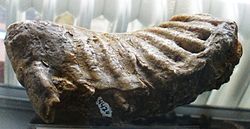- Cyprus Dwarf Elephant
-
Cyprus Dwarf Elephant 
Tooth Conservation status Scientific classification Kingdom: Animalia Phylum: Chordata Class: Mammalia Order: Proboscidea Family: Elephantidae Genus: Elephas Subgenus: Palaeoloxodon Species: E. cypriotes Binomial name Elephas (Palaeoloxodon) cypriotes
BateThe Cyprus Dwarf Elephant (Elephas cypriotes) is an extinct species of elephant related to the living Asian Elephant.
Contents
Description
Believed to be descended from the Straight-tusked Elephant, this much smaller species inhabited Cyprus and some other Mediterranean islands after the Messinian salinity crisis, during the Late Pleistocene. Its estimated body weight was only some 200 kilograms, a weight reduction of 98% from its ancestors which weighed about 10 metric tonnes. The molars are less reduced in scale, being some 40% of the size of the mainland straight-tusked elephants.
The factors responsible for the dwarfing of island mammals are thought to include the reduction in food availability, predation and competition.
The Cyprus dwarf elephant survived at least until 9000 BC. The species is also known under a synonym as Elephas cypriotes bate, which commemorates the first palaeontologist to find and report it, Dorothea Bate.[1]
Excavations
Finds of whole or partial skeletons of this elephant are very rare. The first recorded find was by Dorothea Bate in a cave in the Kyrenia hills of Cyprus in 1902, described in a paper for the Royal Society in 1903[2] and in a later paper for Philosophical Transactions of the Royal Society of London in 1905.[3]
See also
References
- Davies, P., & Lister, A. M., Palaeoloxodon cypriotes, the dwarf elephant of Cyprus: size and scaling comparisons with P. falconeri (Sicily-Malta) and mainland P. antiquus in Cavarretta et al., op. cit. pp. 479–480
- Masseti, M., Did endemic dwarf elephants survive on Mediterranean islands up to protohistorical times? in Cavarretta, Gioia, Mussi & Palombo, La terra degli Elefanti, The World of Elephants (Rome, 2001) pp. 402–406
- Palombo, M. R., Endemic elephants of the Mediterranean Islands: knowledge, problems and perspectives in Cavarretta et al., op. cit.
- Simmons, A. H. (1999). Faunal extinction in an island society: pygmy hippopotamus hunters of Cyprus. Interdisciplinary Contributions to Archaeology. Kluwer Academic/Plenum Publishers. pp. 382. doi:10.1007/b109876. ISBN 978-0306460883. OCLC 41712246. http://google.com/books?id=hCwYwyEBXEAC&printsec=frontcover.
Notes
- ^ Reese, David S.: Men, Saints, or Dragons? in Folklore, Vol. 87, No. 1 (1976), pp. 89-95
- ^ Bate, D. M. A.: Preliminary Note on the Discovery of a Pigmy Elephant in the Pleistocene of Cyprus in Proceedings of the Royal Society of London Vol. 71 (1902 - 1903), pp. 498-500
- ^ ’’Further Note on the Remains of Elephas cypriotes from a Cave-Deposit in Cyprus’’ by Dorothea M. A. Bate in Philosophical Transactions of the Royal Society of London, Series B, Containing Papers of a Biological Character, Vol. 197 (1905), pp. 347-360
Categories:- Prehistoric elephants
- Pleistocene mammals
- Pleistocene extinctions
- Holocene extinctions
- Extinct cave organisms
- Prehistoric Cyprus
Wikimedia Foundation. 2010.
